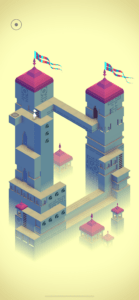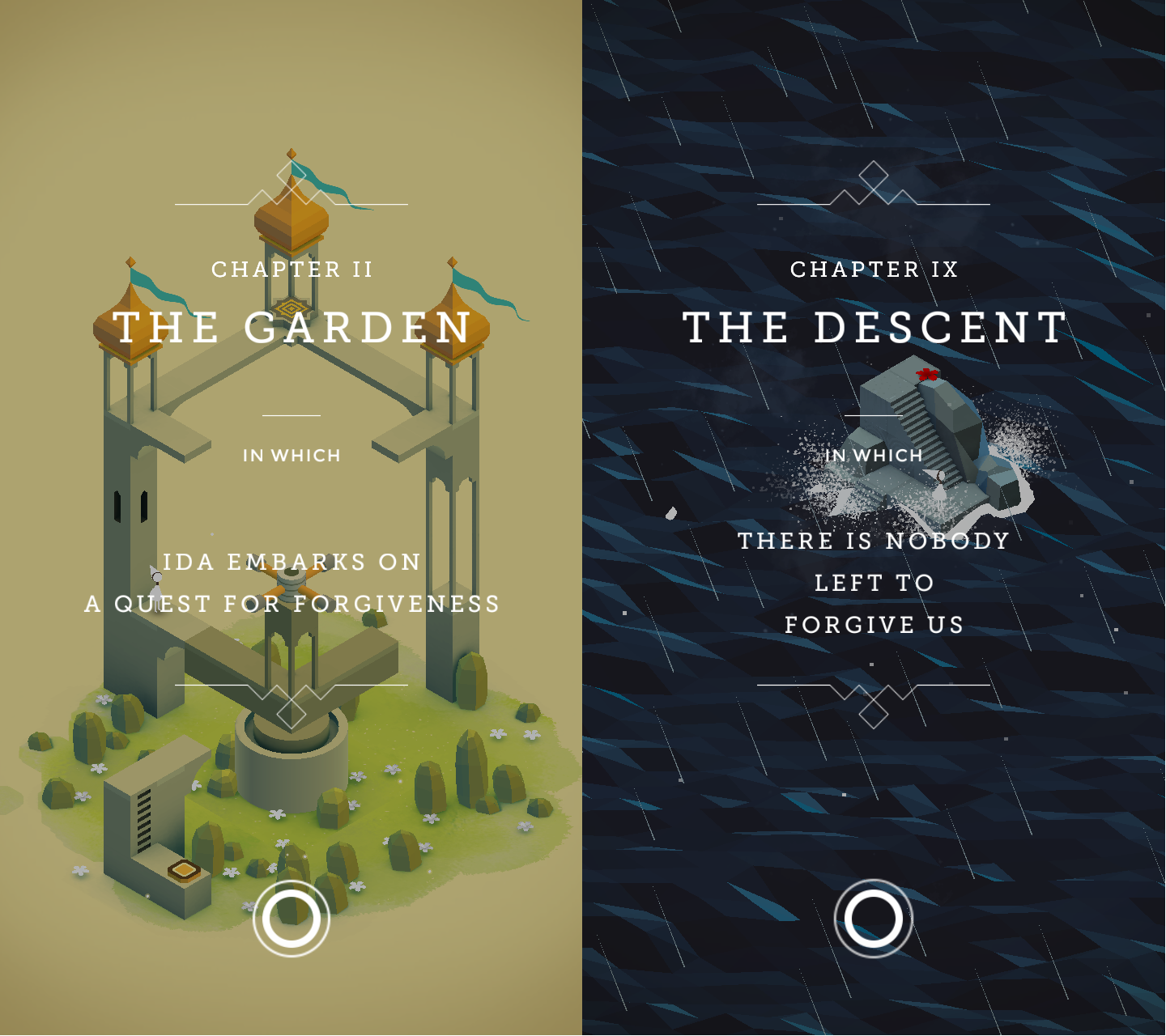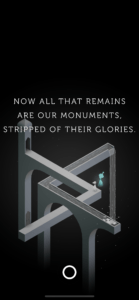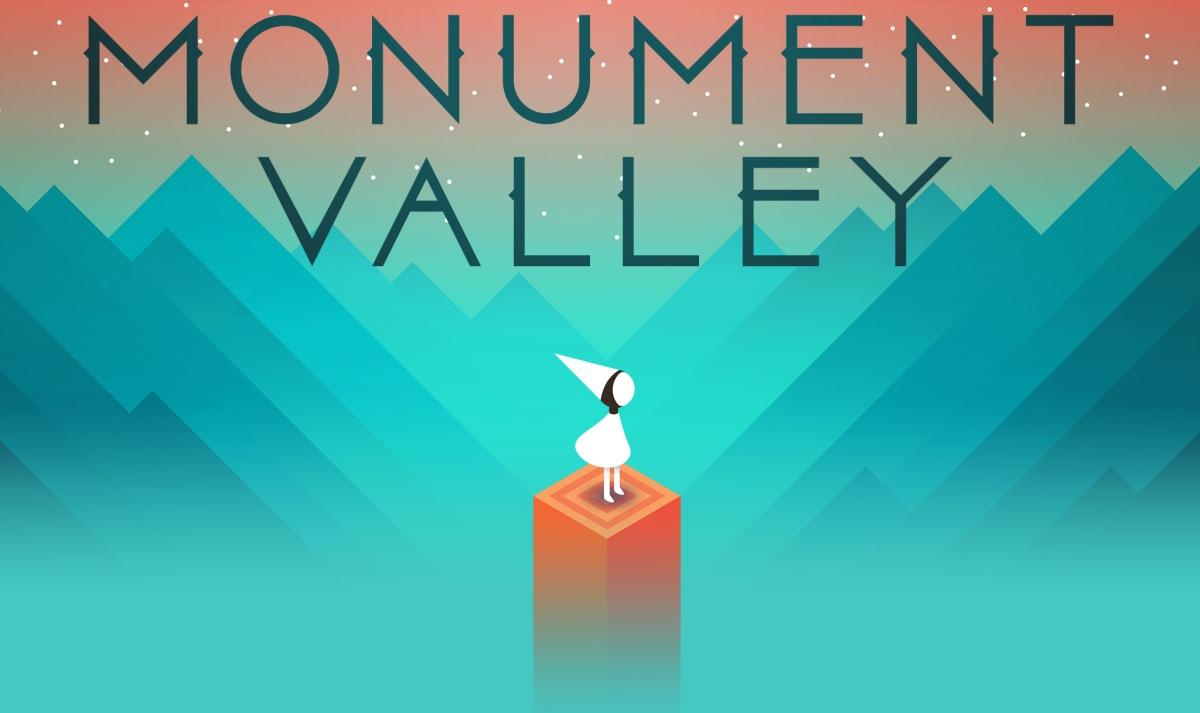Monument Valley is a mobile game released by Ustwo Games in 2014. The game is centered around solving optical illusion based puzzles in order to guide the main character, Princess Ida, out of the maze that makes up each level. This game likely targets players who enjoy solo exploration and puzzle solving, but is relatively lightweight, easy to pick up, and accessible to players of all ages and experience levels.
Monument Valley consists of several core mechanics and elements—the visual and sound design, the optical illusion puzzle solving, and the interactions with NPCs—that give rise to sensation, challenge, and discovery as aesthetics.
From the start, Monument Valley is incredibly well-designed and aesthetically pleasing. Every level, regardless of what part of it you are in or what perspective you are viewing it from, could be a standalone work of illustrative art.

The design of the mazes is reminiscent of other famous works, such as those of M.C. Escher. Interacting with the world also brings in Monument Valley’s sound design. Tapping on different portions of the level as you guide Ida around plays various musical tones. Moving blocks and turning levers are all also accompanied by specific tones that make the experience more immersive. The sounds make it feel like, in some sense, that you are physically moving and dragging around real objects. Monument Valley can thus be viewed as a sensation game—invoking game as sense-pleasure. An important part of the fun of Monument Valley is simply getting to see and interact with an extremely beautiful world. The player is enticed to solve the puzzle and play the game simply because it is a pleasing sensory experience to do so.
However, sensation is not the only aesthetic that Monument Valley creates through its mechanics. The core gameplay is about solving puzzles—manipulating the mazes and optical illusions in order to get Ida to the end point. It is quite literally an obstacle course for both Ida and the player, who must figure out the right sequence of moves—sliding blocks, avoiding crow people, moving totems, rotating the architecture—to get Ida to where she needs to go. Thus, Monument Valley invokes the aesthetic of challenge as well. This is further emphasized by the subtleness that exists in the game. Many of the key mechanics (especially how certain objects move), while briefly hinted at in the splash text before each level, are largely left up to the player to discover and interpret how to use. Rather than telling the player explicitly what certain things do, Monument Valley uses visual cues, such as different colored panels, or the horizontal or vertical alignment of circular windows on sliding platforms to indicate which direction you can slide them in.

Figuring both this and the way put them all together towards the larger end goal creates the aesthetic of challenge in Monument Valley. Personally, realizing that rotating certain objects would bridge what at first looked like impossible gaps was incredibly rewarding.
Finally, Monument Valley also invokes the aesthetic of discovery through its mechanics—especially the way in which it reveals the larger narrative in bits and pieces. Sometimes the level introduction will hint at a larger story, or more about Ida in general, such as stating that she is “embarking on a quest for forgiveness”.

There will also be occasions where Ida runs into this blue, spectral NPC, who will ask her questions. Through this, we are given more cryptic information—that Ida is a princess, both silent and thieving—and that something has happened to her kingdom and her people.



This mechanic helps invoke discovery because the player, in presumably wanting to find out more about the backstory of this world, solves the puzzles to move forward and get to the next point they will be offered more information. Additionally, this also involves some level of embedded narrative—there exists a story that only unfolds as the players progresses through the game, interacts with the environment, and listens to what the NPCs have to say. However, while Monument Valley tells its story extremely well as is, for players more interested or invested in the narrative a game has to offer, this kind of storytelling may be a little slow and sparse. I personally think the backstory is extremely interesting, but I wish I was given more of it more often, rather than having to complete an indeterminate amount of puzzles before progressing the narrative.
Overall though, Monument Valley is incredibly well executed. It invokes multiple aesthetics—sensation, challenge, and discovery—through its core mechanics.



